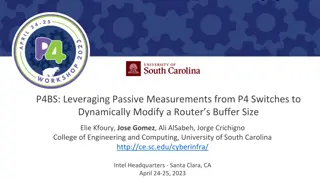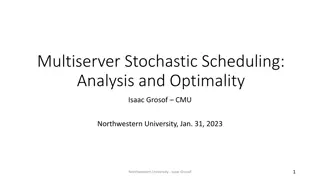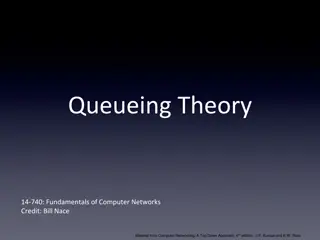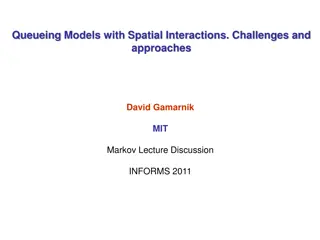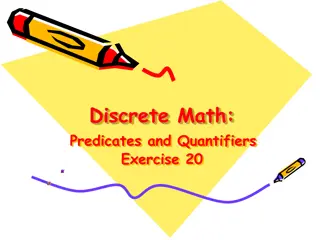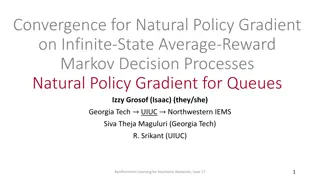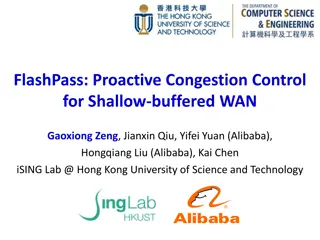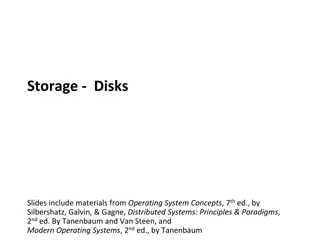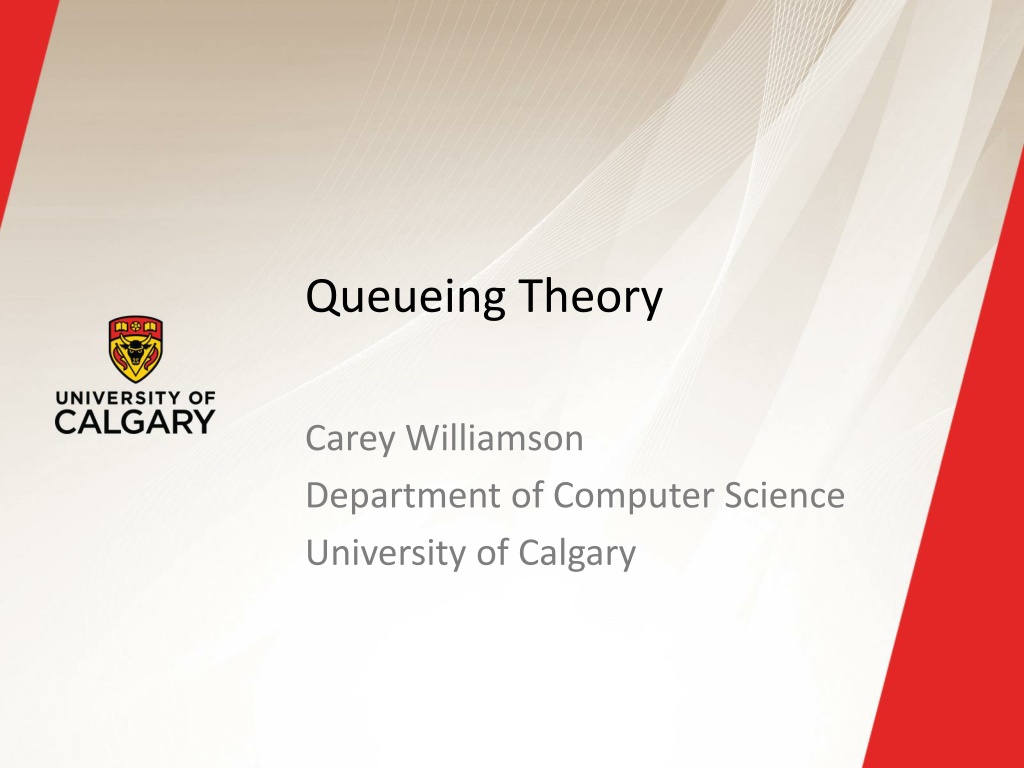
Understanding Queueing Theory in System Modeling
Dive into the basics of queueing theory, exploring notation, terminology, and various queueing models. Learn how queue-based models help assess system performance efficiently and gain insights into key system properties. Discover the implicit assumptions and advanced variations of queueing models.
Download Presentation

Please find below an Image/Link to download the presentation.
The content on the website is provided AS IS for your information and personal use only. It may not be sold, licensed, or shared on other websites without obtaining consent from the author. If you encounter any issues during the download, it is possible that the publisher has removed the file from their server.
You are allowed to download the files provided on this website for personal or commercial use, subject to the condition that they are used lawfully. All files are the property of their respective owners.
The content on the website is provided AS IS for your information and personal use only. It may not be sold, licensed, or shared on other websites without obtaining consent from the author.
E N D
Presentation Transcript
Queueing Theory Carey Williamson Department of Computer Science University of Calgary
2 Outline Plan: Introduce basics of Queueing Theory Define notation and terminology used Discuss properties of queueing models Show examples of queueing analysis: M/M/1 queue Variations on the M/G/1 queue Open queueing network models Closed queueing network models
3 Queueing Theory Basics Queueing theory provides a very general framework for modeling systems in which customers must line up (queue) for service (use of resource) Banks (tellers) Restaurants (tables and seats) Computer systems (CPU, disk I/O) Networks (Web server, router, WLAN)
4 Queue-based Models Queueing model represents: Arrival of jobs (customers) into system Service time requirements of jobs Waiting of jobs for service Departures of jobs from the system Typical diagram: Customer Arrivals Departures Server Buffer
5 Why Queue-based Models? In many cases, the use of a queueing model provides a quantitative way to assess system performance Expected waiting time for service Number of buffers required to limit loss of customers Response time (e.g., Web page download time) Throughput (e.g., job completions per second) Reveals key system insights (properties) Often with efficient, closed-form calculation
6 Caveats and Assumptions In many cases, using a queueing model has the following implicit underlying assumptions: Poisson arrival process Exponential service time distribution Single server Infinite capacity queue First-Come-First-Serve (FCFS) discipline (a.k.a. FIFO) Note: important role of memoryless property!
7 Advanced Queueing Models There is a tonne of published work on variations of the basic model: Correlated arrival processes General (G) service time distributions Multiple servers Vacationing servers Finite capacity systems Other scheduling disciplines (non-FIFO) We will start with the basics!
8 Queue Notation Queues are concisely described using the Kendall notation, which specifies: Arrival process for jobs {M, D, G, } Service time distribution {M, D, G, } Number of servers {1, n} Storage capacity (buffers) {B, infinite} Service discipline {FIFO, PS, SRPT, } Examples: M/M/1, M/G/1, M/M/c/c
9 The M/M/1 Queue Assumes Poisson arrival process, exponential service times, single server, FCFS service discipline, infinite capacity for storage, with no loss Notation: M/M/1 Markovian arrival process (Poisson) Markovian service times (exponential) Single server (FCFS, infinite capacity)
10 The M/M/1 Queue (cont d) Arrival rate: (e.g., customers/sec) Inter-arrival times are exponentially distributed and independent with mean 1 / Service rate: (e.g., customers/sec) Service times are exponentially distributed and independent with mean 1 / System load: = / 0 1 (also known as utilization factor) Stability criterion: < 1 (single server systems)
11 Queue Performance Metrics N: Avg number of customers in system as a whole, including any in service Q: Avg number of customers in the queue (only), excluding any in service W: Average waiting time in queue (only) T: Avg time spent in system as a whole, including waiting time plus service time Note: Little s Law: N = T
12 M/M/1 Queue Results Average number of customers in the system: N = / (1 ) Variance: Var(N) = / (1 - )2 Waiting time: W = / ( (1 )) Time in system: T = 1 / ( (1 ))
13 The M/D/1 Queue Assumes Poisson arrival process, deterministic (constant) service times, single server, FCFS service discipline, infinite capacity for storage, no loss Notation: M/D/1 Markovian arrival process (Poisson) Deterministic service times (constant) Single server (FCFS, infinite capacity)
14 M/D/1 Queue Results Average number of customers: Q = /(1 ) 2 / (2 (1 - )) Waiting time: W = x / (2 (1 )) where x is the mean service time Note that lower variance in service time means less queueing occurs
15 The M/G/1 Queue Assumes Poisson arrival process, general service times, single server, FCFS service discipline, infinite capacity for storage, with no loss Notation: M/G/1 Markovian arrival process (Poisson) General service times (must specify F(x)) Single server (FCFS, infinite capacity)
16 M/G/1 Queue Results Average number of customers: Q = + 2 (1 + C2) / (2 (1 - )) where C is the Coefficient of Variation (CoV) for the service-time distribution F(x) Waiting time: W = x (1 + C2 ) / (2 (1 )) where x is the mean service time from distribution F(x) Note that variance of the service time distn could be higher or lower than for exponential distn!
17 The G/G/1 Queue Assumes general arrival process, general service times, single server, FCFS service discipline, infinite capacity for storage, with no loss Notation: G/G/1 General arrival process (specify G(x)) General service times (must specify F(x)) Single server (FCFS, infinite capacity)
18 Queueing Network Models So far we have been talking about a queue in isolation In a queueing network model, there can be multiple queues, connected in series or in parallel (e.g., CPU, disk, teller) Two versions: Open queueing network models Closed queueing network models
19 Open Queueing Network Models Assumes that arrivals occur externally from outside the system Infinite population, with a fixed arrival rate, regardless of how many are in the system Unbounded number of customers are permitted within the system Departures leave the system (forever)
20 Closed Queueing Network Models Assumes that there is a finite number of customers, in a self-contained world Finite population; arrival rate varies depending on how many and where Fixed number of customers (N) that recirculate in the system (forever) Can be analyzed using Mean Value Analysis (MVA), recurrence relations, and balance equations


